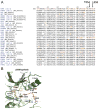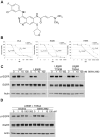Acquired resistance to epidermal growth factor receptor kinase inhibitors associated with a novel T854A mutation in a patient with EGFR-mutant lung adenocarcinoma
- PMID: 19010870
- PMCID: PMC2596620
- DOI: 10.1158/1078-0432.CCR-08-0151
Acquired resistance to epidermal growth factor receptor kinase inhibitors associated with a novel T854A mutation in a patient with EGFR-mutant lung adenocarcinoma
Abstract
Purpose: Somatic mutations in the tyrosine kinase domain of the epidermal growth factor receptor (EGFR) gene are associated with sensitivity of lung adenocarcinomas to the EGFR tyrosine kinase inhibitors, gefitinib and erlotinib. Acquired drug resistance is frequently associated with a secondary somatic mutation that leads to the substitution of methionine for threonine at position 790 (T790M). We aimed to identify additional second-site alterations associated with acquired resistance.
Experimental design: Tumor samples were obtained from 48 patients with acquired resistance. Tumor cell DNA was analyzed for EGFR kinase domain mutations. Molecular analyses were then done to characterize the biological properties of a novel mutant EGFR allele.
Results: A previously unreported mutation in exon 21 of EGFR, which leads to substitution of alanine for threonine at position 854 (T854A), was identified in one patient with a drug-sensitive EGFR L858R-mutant lung adenocarcinoma after long-term treatment with tyrosine kinase inhibitors. The T854A mutation was not detected in a pretreatment tumor sample. The crystal structure analyses of EGFR suggest that the T854 side chain is within contact distance of gefitinib and erlotinib. Surrogate kinase assays show that the EGFR T854A mutation abrogates the inhibition of tyrosine phosphorylation by erlotinib. Such resistance seems to be overcome by a new irreversible dual EGFR/HER2 inhibitor, BIBW 2992.
Conclusions: The T854A mutation is the second reported second-site acquired resistance mutation that is within contact distance of gefitinib and erlotinib. These data suggest that acquired resistance to ATP-mimetic EGFR kinase inhibitors may often be associated with amino acid substitutions that alter drug contact residues in the EGFR ATP-binding pocket.
Figures




References
-
- Lynch TJ, Bell DW, Sordella R, et al. Activating mutations in the epidermal growth factor receptor underlying responsiveness of non-small-cell lung cancer to gefitinib. N Engl J Med. 2004;350:2129–39. - PubMed
-
- Paez JG, Janne PA, Lee JC, et al. EGFR mutations in lung cancer: correlation with clinical response to gefitinib therapy. Science. 2004;304:1497–500. - PubMed
-
- Riely GJ, Pao W, Pham D, et al. Clinical course of patients with non-small cell lung cancer and epidermal growth factor receptor exon 19 and exon 21 mutations treated with gefitinib or erlotinib. Clin Cancer Res. 2006;12:839–44. - PubMed
-
- Jackman DM, Yeap BY, Sequist LV, et al. Exon 19 deletion mutations of epidermal growth factor receptor are associated with prolonged survival in non-small cell lung cancer patients treated with gefitinib or erlotinib. Clin Cancer Res. 2006;12:3908–14. - PubMed
Publication types
MeSH terms
Substances
Grants and funding
LinkOut - more resources
Full Text Sources
Other Literature Sources
Medical
Molecular Biology Databases
Research Materials
Miscellaneous

